9 Low-Maintenance Landscaping Ideas for the Pacific Northwest
BY RELA CATUCOD | MAY 15TH, 2023 | LAWN CARE, PACIFIC NORTHWESTAs a homeowner, you’re searching for low-maintenance landscaping ideas for the Pacific Northwest that suit your busy lifestyle. In a region filled with captivating cities like Seattle and Portland and the breathtaking Idaho landscapes, there’s always something to do, from hiking to skiing. So, who has time for endless yard work?
The Pacific Northwest has an incredibly diverse climate, ranging from the mild, rainy coastlines to the colder, drier mountains. As a local, it’s crucial to find landscaping ideas that can thrive in these conditions. If you’re curious about how you can transform your garden into a low-maintenance outdoor oasis, check out the tips below.
In this article, we’ll explore:
- Select Low-Maintenance Perennials
- Opt for Native Plants
- Add Groundcovers to Your Garden Beds
- Utilize Mulch and Organic Matter
- Design Walkways with Pavers
- Minimize Mowing with Alternative Front Yard Ideas
- Create Shade Gardens and Full Sun Spaces
- Incorporate Water Features
- Install Efficient Irrigation Systems
1. Select Low-Maintenance Perennials
Adding perennials to your garden is one way to create a visually stunning and easy-to-maintain landscape. The good thing is the Pacific Northwest is home to a wide variety of native perennials that can flourish in the region’s unique climate.
By introducing native perennials into your landscape, you can sit back and enjoy their beauty without spending endless hours on watering, fertilizing, and pest control. Moreover, perennials have a significant advantage over annuals as they don’t need to be planted each year, helping you save time, money, and effort.
Some popular low-maintenance perennials for Seattle, Portland, and other PNW gardens include:
- White Sage (Artemisia ludoviciana)
- Cardinal Flower (Lobelia cardinalis)
- Black-eyed Susan (Rudbeckia hirta)
- Milky Bellflower (Campanula lactiflora)
Benefits of low-maintenance perennials:
- Long-lasting blooms
- Minimal fertilizing required
- Attracts pollinators like hummingbirds
- Low upkeep and pruning needs
Estimated cost: The estimated cost for incorporating these plants into your landscape ranges from $10 to $100 per plant, depending on size, location, and variety.
2. Opt for Native Plants
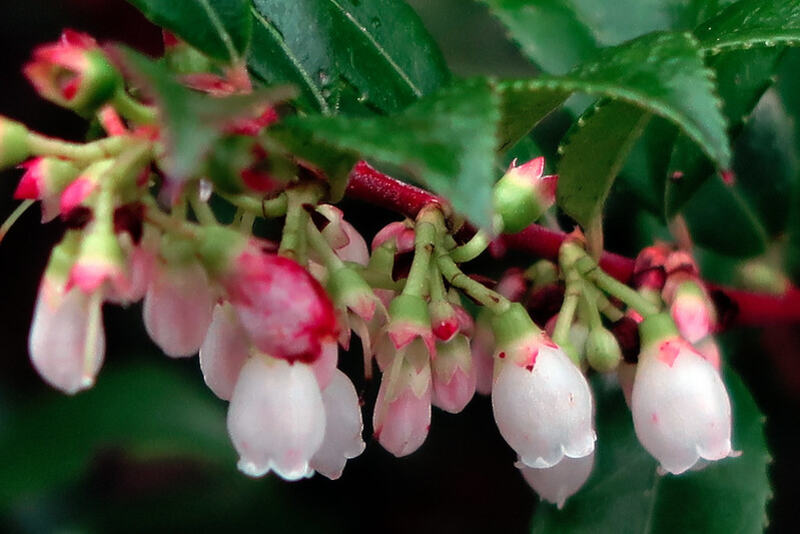
Evergreen Huckleberry
Photo Credit: John Rusk / Flickr / CC BY 2.0
Native plants are low-maintenance options that require less water, fertilizers, and care than non-native species. They also provide essential habitats and food sources for local wildlife and pollinators, such as butterflies and hummingbirds, contributing to a healthy and biodiverse ecosystem.
These plants are well-adapted to the unique climates and soil conditions found across Oregon, Washington, and Idaho. By using native plants, homeowners can create a more sustainable and environmentally friendly outdoor space.
Some Pacific Northwest native plants include:
- Sword Fern (Polystichum munitum)
- Dull Oregon Grape (Mahonia nervosa)
- Red-Twig Dogwood (Cornus sericea)
- Salal (Gaultheria shallon)
- Evergreen Huckleberry (Vaccinium ovatum)
Advantages of native plants:
- Require less water and fertilizer
- Support local wildlife and pollinators
- Resistant to local pests and diseases
- Adapted to local climate and soil conditions
Estimated cost: Similar to perennials, native plant prices in the Pacific Northwest can vary significantly based on factors such as type, size, and location of purchase. On average, you can expect to spend between $15 to $50 per shrub, $5 to $50 per vine, and $200 to $1,500 per tree when incorporating native plants into your landscape.
3. Add Groundcovers to Your Garden Beds
Groundcovers make a fantastic addition to Pacific Northwest gardens for numerous reasons. Not only do they help prevent soil erosion and suppress weed growth, but they also add visual interest to your landscape. Their ability to quickly spread across the ground can create a lush carpet, providing an attractive alternative to traditional grass lawns.
In the Pacific Northwest, where rainfall is plentiful, groundcovers can also help with water conservation by reducing evaporation and improving water absorption in the soil. This makes them a practical and eco-friendly choice for homeowners who want to create a low-maintenance and sustainable garden. They come in a variety of colors, textures, and growth habits, allowing you to create a unique and personalized landscape design.
Some popular low-maintenance groundcovers include:
- Goatsbeard (Aruncus dioicus)
- Sword Fern (Polystichum munitum)
- Pacific Bleeding Heart (Dicentra formosa)
- Silverweed (Potentilla anserina)
- Lingonberry (Vaccinium vitis–idaea)
- Wild Strawberry (Fragaria vesca)
Benefits of groundcovers:
- Reduce weed growth
- Prevent soil erosion
- Low watering requirements
- Add texture and color to garden beds
- Turfgrass alternative (which means less mowing)
Estimated cost: You can expect to spend between $5 and $50 per plant. Keep in mind that purchasing plants in larger quantities or from local nurseries may help reduce the overall cost.
4. Utilize Mulch and Organic Matter
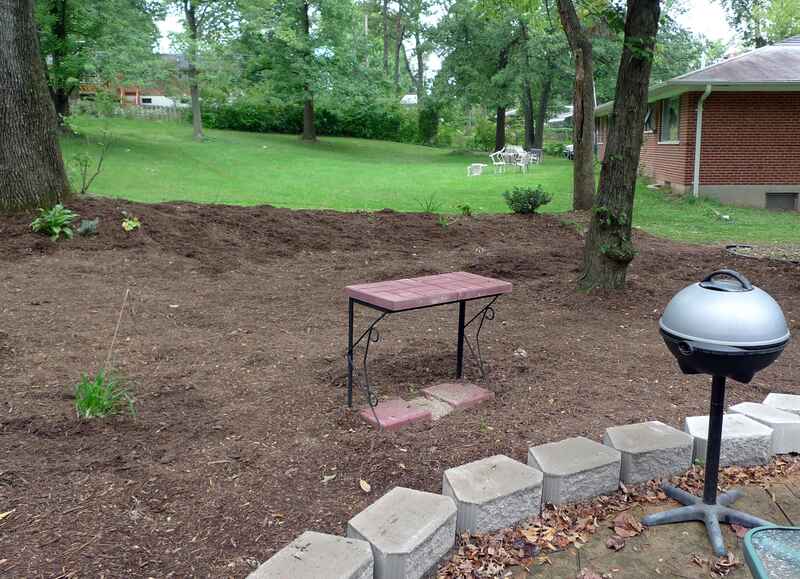
Photo Credit: christina rutz / Flickr / CC BY 2.0
Using mulch is an excellent way to create a low-maintenance garden. It offers plenty of benefits, such as retaining moisture and regulating soil temperature. It also acts as a barrier against pesky weeds, saving you time and money on weed control.
Organic mulches, such as wood chips and bark, are great choices for many gardens in the area. Not only do they provide the benefits mentioned above, they also add nutrients to the soil. This helps boost overall soil health and support the growth of your plants. Thus, making organic mulch a must-buy for Pacific Northwest gardeners.
Types of mulch:
- Inorganic mulch: Rock, stone, landscape glass, rubber mulch, landscape fabric
- Organic mulch: Leaves, wood chips, bark, pine needles, grass clippings
Advantages of mulch:
- Retains moisture
- Suppresses weeds
- Regulates soil temperature
- Adds nutrients to the soil (organic mulches)
Estimated cost: On average, homeowners can expect to pay between $3 to $5 per 2-cubic-foot bag of wood chips or bark mulch. For larger landscaping projects, it’s often more cost-effective to purchase mulch in bulk, which can range from $20 to $50 per cubic yard.
5. Design Walkways with Pavers

Photo Credit: Jit Lim / Canva Pro / License
Pavers offer a practical and eco-friendly solution for designing walkways, patio, and other hardscaping elements in your Pacific Northwest landscape. By adding pavers in your outdoor living area, you can make your space more appealing and low-maintenance.
There are various types of pavers you can incorporate around your home, ensuring you can find a design that can fit your style and complement your garden. With the proper installation, pavers also allow for efficient water drainage, making them an environmentally friendly choice for the often rainy Pacific Northwest climate.
Types of pavers:
- Concrete pavers
- Brick pavers
- Natural stone pavers
- Rubber pavers
- Cobblestone pavers
- Wood pavers
Advantages of pavers:
- Durable and long-lasting
- Low maintenance
- Permeable options for stormwater management
- Easy to replace or repair
Estimated cost: The estimated cost of using pavers in your landscape design varies depending on factors such as the type of pavers selected, the size of the project, and labor costs in your area. Generally, homeowners can expect to spend anywhere between $10 and $25 per square foot for paver installation.
6. Minimize Mowing with Alternative Front Yard Ideas
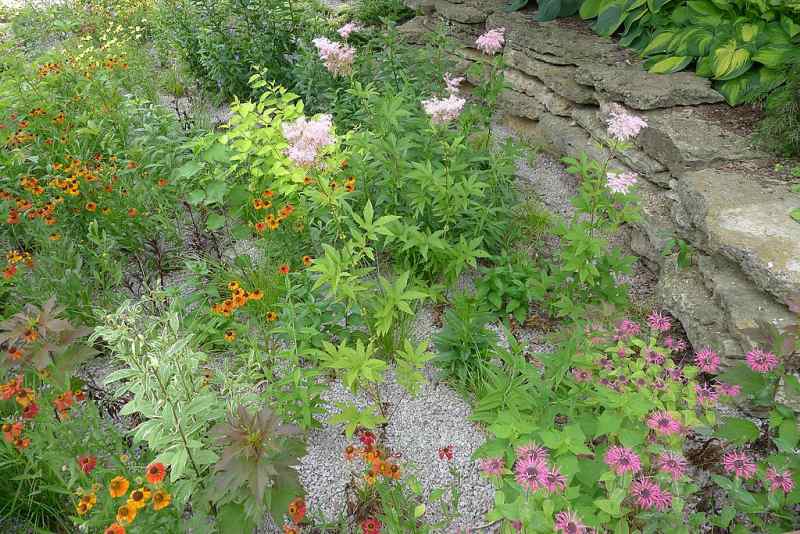
Photo Credit: James Steakley / Wikimedia Commons / CC BY-SA 4.0
Traditional lawns can be a hassle to maintain, but alternative landscaping ideas offer eye-catching, low-maintenance solutions for busy Pacific Northwest homeowners. Rock gardens and wildflower meadows, for example, create stunning focal points while requiring minimal care and attracting pollinators.
Small garden designs featuring native groundcovers and shade-loving perennials provide a welcoming outdoor haven with little upkeep. By opting for these alternatives, you’ll enjoy a beautiful, eco-friendly landscape without the time-consuming maintenance tasks.
Alternative front yard ideas:
- Rock gardens
- Wildflower meadows
- Small garden designs
- Ornamental grass gardens
- Xeriscaping
- Rain gardens
Advantages of alternative front yard ideas:
- Reduces mowing and lawn care
- Conserves water and resources
- Enhances curb appeal
- Provides habitat for local wildlife
Estimated cost: The estimated cost of establishing a rock garden can range from $500 to $1,500, depending on the size and materials used. For wildflower meadows or small garden designs, the cost varies based on plant selections, with an average range of $10 to $50 per plant.
7. Create Shade Gardens and Full Sun Spaces
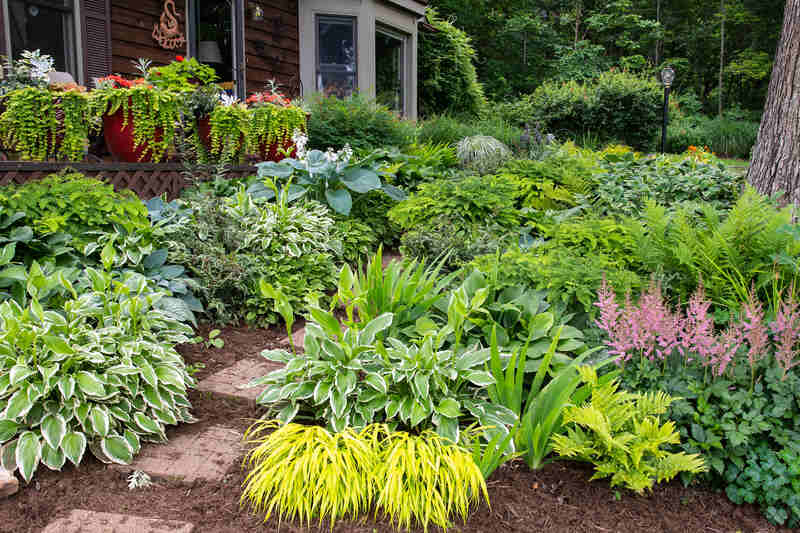
Photo credit: Mark Levisay / Flickr / CC BY 2.0
When designing your Pacific Northwest garden, it’s crucial to consider the amount of sunlight each area in your outdoor space receives. This will guide you in creating thriving, personalized spaces, from cozy shade gardens with lounge areas to full sun spaces filled with drought-tolerant plants.
For your shaded retreats, consider weaving in plants like hostas, ferns, and conifers that can happily grow without much sunlight. Meanwhile, in your sun-kissed areas, go for drought-tolerant plants like coneflowers, yarrow, and ornamental grasses. By doing so, you’ll cultivate a garden design that’s not only visually captivating but also delightfully low maintenance.
Advantages of shade gardens and full sun spaces:
- Plants are suited to their environment
- Reduced watering requirements
- Low maintenance and care
- Increased biodiversity in your landscape
Estimated cost: Shade-loving plants can cost anywhere from $5 to $40 each plant, while drought-tolerant plants can cost anywhere from $8 to $50 per plant. The total cost will be determined by various factors, such as plant size and variety, as well as the number of plants required to complete your garden design.
8. Incorporate Water Features

Photo Credit: Pixabay
Incorporating a water feature, such as a pond or fountain, into your landscape design can create a visually appealing focal point that enhances the overall atmosphere of your outdoor living space. The soothing sounds of flowing water can provide a calming ambiance, perfect for unwinding after a long day or enjoying a weekend with family and friends.
Types of water features:
- Ponds
- Fountains
- Waterfalls
- Streams
- Birdbaths
Advantages of water features:
- Improve the visual appeal of your home
- Attract birds and other wildlife
- Reduce noise pollution
- Low maintenance
Estimated cost: A water feature in your garden can cost anywhere from $200 for a tiny DIY fountain to over $5,000 for a professionally placed pond.
9. Install Efficient Irrigation Systems
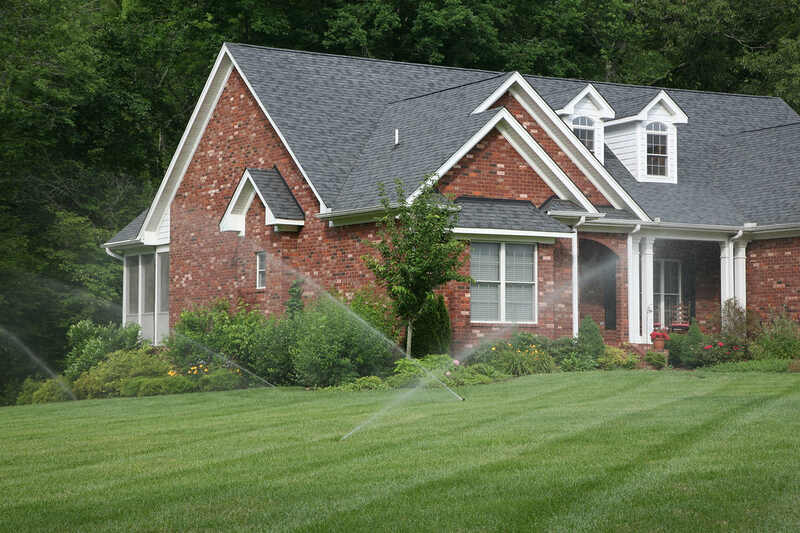
Photo Credit: Aqua Mechanical / Flickr / CC BY 2.0
It’s best to install an efficient irrigation system to ensure the health and beauty of your low-maintenance garden in the Pacific Northwest. A well-designed system not only helps maintain your garden beds but also contributes to water conservation efforts. By using drip irrigation, soaker hoses, or smart sprinklers, you can provide the right amount of water to your plants while reducing water waste.
Types of irrigation systems:
- Drip irrigation
- Soaker hoses
- Sprinkler systems
- Smart sprinklers
- In-ground irrigation systems
Advantages of irrigation systems:
- Conserve water with efficient irrigation
- Reduce manual watering and maintenance
- Promote healthier plant growth
Estimated cost: You may anticipate paying between $1,500 and $5,000 on an efficient irrigation system, depending on the size of your garden and the intricacy of the system.
FAQ about Low-Maintenance Pacific Northwest Landscaping
Organic mulches such as shredded bark, wood chips, or compost are ideal for low-maintenance landscaping in the Pacific Northwest region. As they decompose, these materials help to suppress weeds, retain moisture, and improve soil quality.
To create a low-maintenance rain garden, choose a location that collects runoff from roofs, driveways, or other impervious surfaces. Use native plants that are well-adapted to the region’s climate and can tolerate both wet and dry conditions.
Low-maintenance hardscaping ideas for the Pacific Northwest include using permeable pavers for walkways and patios, creating rock gardens with native stones and plants, and installing attractive, durable, and weather-resistant outdoor furniture to create inviting outdoor living spaces. These elements require minimal upkeep and can withstand the region’s climate conditions.
Professional Pacific Northwest Landscape Maintenance
Embracing low-maintenance landscaping is the key to enjoying your weekends in the beautiful Pacific Northwest. However, it’s important to remember that low maintenance doesn’t mean zero maintenance, and some outdoor tasks will still need your attention.
Instead of spending your valuable time on outdoor upkeep, consider connecting with a local lawn care pro that can handle ayour lawn care needs. This way, you can spend more time exploring the breathtaking landscapes of Oregon, Washington, and Idaho or simply relaxing in your own outdoor oasis.
Main Image Credit: Wonderlane / Flickr / Public Domain